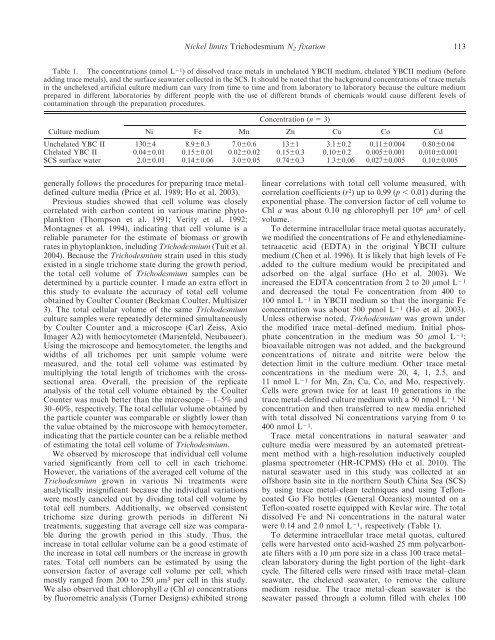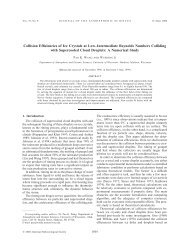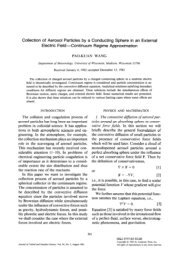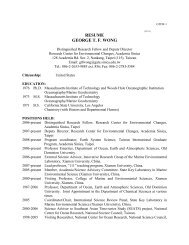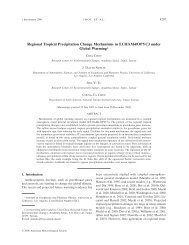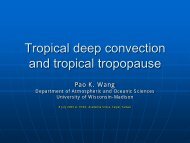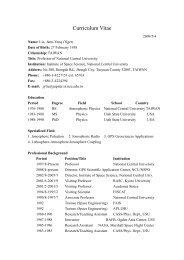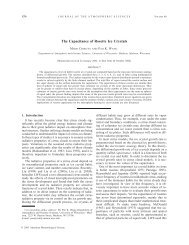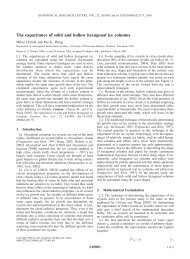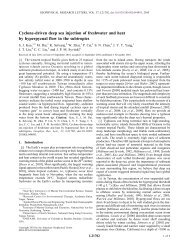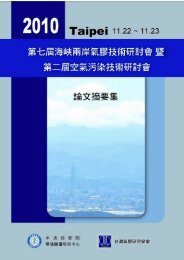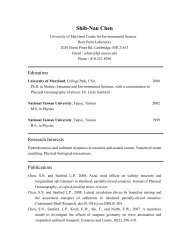Ho, Tung-Yuan. Nickel limitation of nitrogen ... - Academia Sinica
Ho, Tung-Yuan. Nickel limitation of nitrogen ... - Academia Sinica
Ho, Tung-Yuan. Nickel limitation of nitrogen ... - Academia Sinica
- No tags were found...
Create successful ePaper yourself
Turn your PDF publications into a flip-book with our unique Google optimized e-Paper software.
<strong>Nickel</strong> limits Trichodesmium N 2 fixation 113Table 1. The concentrations (nmol L 21 ) <strong>of</strong> dissolved trace metals in unchelated YBCII medium, chelated YBCII medium (beforeadding trace metals), and the surface seawater collected in the SCS. It should be noted that the background concentrations <strong>of</strong> trace metalsin the unchelexed artificial culture medium can vary from time to time and from laboratory to laboratory because the culture mediumprepared in different laboratories by different people with the use <strong>of</strong> different brands <strong>of</strong> chemicals would cause different levels <strong>of</strong>contamination through the preparation procedures.Concentration (n 5 3)Culture mediumNi Fe Mn Zn Cu Co CdUnchelated YBC II 13064 8.960.3 7.060.6 1361 3.160.2 0.1160.004 0.8060.04Chelated YBC II 0.0460.01 0.1560.01 0.0260.02 0.1560.3 0.1060.2 0.00560.001 0.01060.001SCS surface water 2.060.01 0.1460.06 3.060.05 0.7460.3 1.360.06 0.02760.005 0.1060.005generally follows the procedures for preparing trace metal–defined culture media (Price et al. 1989; <strong>Ho</strong> et al. 2003).Previous studies showed that cell volume was closelycorrelated with carbon content in various marine phytoplankton(Thompson et al. 1991; Verity et al. 1992;Montagnes et al. 1994), indicating that cell volume is areliable parameter for the estimate <strong>of</strong> biomass or growthrates in phytoplankton, including Trichodesmium (Tuit et al.2004). Because the Trichodesmium strain used in this studyexisted in a single trichome state during the growth period,the total cell volume <strong>of</strong> Trichodesmium samples can bedetermined by a particle counter. I made an extra effort inthis study to evaluate the accuracy <strong>of</strong> total cell volumeobtained by Coulter Counter (Beckman Coulter, Multisizer3). The total cellular volume <strong>of</strong> the same Trichodesmiumculture samples were repeatedly determined simultaneouslyby Coulter Counter and a microscope (Carl Zeiss, AxioImager A2) with hemocytometer (Marienfeld, Neubaueer).Using the microscope and hemocytometer, the lengths andwidths <strong>of</strong> all trichomes per unit sample volume weremeasured, and the total cell volume was estimated bymultiplying the total length <strong>of</strong> trichomes with the crosssectionalarea. Overall, the precision <strong>of</strong> the replicateanalysis <strong>of</strong> the total cell volume obtained by the CoulterCounter was much better than the microscope – 1–5% and30–60%, respectively. The total cellular volume obtained bythe particle counter was comparable or slightly lower thanthe value obtained by the microscope with hemocytometer,indicating that the particle counter can be a reliable method<strong>of</strong> estimating the total cell volume <strong>of</strong> Trichodesmium.We observed by microscope that individual cell volumevaried significantly from cell to cell in each trichome.<strong>Ho</strong>wever, the variations <strong>of</strong> the averaged cell volume <strong>of</strong> theTrichodesmium grown in various Ni treatments wereanalytically insignificant because the individual variationswere mostly canceled out by dividing total cell volume bytotal cell numbers. Additionally, we observed consistenttrichome size during growth periods in different Nitreatments, suggesting that average cell size was comparableduring the growth period in this study. Thus, theincrease in total cellular volume can be a good estimate <strong>of</strong>the increase in total cell numbers or the increase in growthrates. Total cell numbers can be estimated by using theconversion factor <strong>of</strong> average cell volume per cell, whichmostly ranged from 200 to 250 mm 3 per cell in this study.We also observed that chlorophyll a (Chl a) concentrationsby fluorometric analysis (Turner Designs) exhibited stronglinear correlations with total cell volume measured, withcorrelation coefficients (r 2 ) up to 0.99 (p , 0.01) during theexponential phase. The conversion factor <strong>of</strong> cell volume toChl a was about 0.10 ng chlorophyll per 10 6 mm 3 <strong>of</strong> cellvolume.To determine intracellular trace metal quotas accurately,we modified the concentrations <strong>of</strong> Fe and ethylenediaminetetraaceticacid (EDTA) in the original YBCII culturemedium (Chen et al. 1996). It is likely that high levels <strong>of</strong> Feadded to the culture medium would be precipitated andadsorbed on the algal surface (<strong>Ho</strong> et al. 2003). Weincreased the EDTA concentration from 2 to 20 mmol L 21and decreased the total Fe concentration from 400 to100 nmol L 21 in YBCII medium so that the inorganic Feconcentration was about 500 pmol L 21 (<strong>Ho</strong> et al. 2003).Unless otherwise noted, Trichodesmium was grown underthe modified trace metal–defined medium. Initial phosphateconcentration in the medium was 50 mmol L 21 ;bioavailable <strong>nitrogen</strong> was not added, and the backgroundconcentrations <strong>of</strong> nitrate and nitrite were below thedetection limit in the culture medium. Other trace metalconcentrations in the medium were 20, 4, 1, 2.5, and11 nmol L 21 for Mn, Zn, Cu, Co, and Mo, respectively.Cells were grown twice for at least 10 generations in thetrace metal–defined culture medium with a 50 nmol L 21 Niconcentration and then transferred to new media enrichedwith total dissolved Ni concentrations varying from 0 to400 nmol L 21 .Trace metal concentrations in natural seawater andculture media were measured by an automated pretreatmentmethod with a high-resolution inductively coupledplasma spectrometer (HR-ICPMS) (<strong>Ho</strong> et al. 2010). Thenatural seawater used in this study was collected at an<strong>of</strong>fshore basin site in the northern South China Sea (SCS)by using trace metal–clean techniques and using TefloncoatedGo Flo bottles (General Oceanics) mounted on aTeflon-coated rosette equipped with Kevlar wire. The totaldissolved Fe and Ni concentrations in the natural waterwere 0.14 and 2.0 nmol L 21 , respectively (Table 1).To determine intracellular trace metal quotas, culturedcells were harvested onto acid-washed 25 mm polycarbonatefilters with a 10 mm pore size in a class 100 trace metal–clean laboratory during the light portion <strong>of</strong> the light–darkcycle. The filtered cells were rinsed with trace metal–cleanseawater, the chelexed seawater, to remove the culturemedium residue. The trace metal–clean seawater is theseawater passed through a column filled with chelex 100


